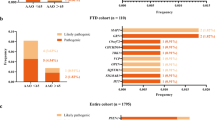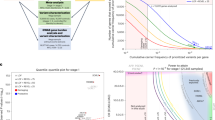Abstract
Alzheimer’s disease (AD) is the most prevalent form of dementia in the world. The neuropathological characteristics of AD patients are the accumulation of extracellular plaques of β-amyloid (Aβ) and intracellular hyperphosphorylated tau protein. Transthyretin (TTR) may alleviate AD symptom by reducing Aβ concentration in the brain. There were reports for a decreased TTR level in both AD brain and blood. However, there is still no robust evidence to support the genetic association of the TTR gene with AD. In this study, we aimed to investigate the potential association of TTR variation with AD by directly sequencing the whole exons and the promoter region of the TTR gene in 529 AD patients and 334 healthy controls from Han Chinese population. We found no association between TTR common variants and AD but observed an enrichment of TTR rare variants in AD patients relative to controls. Further in silico prediction analysis and functional assessment at the cellular level identified four potentially pathogenic rare variants in AD patients. In particular, variant c.-239C>A could potentially downregulate the TTR promoter activity; c.200+4A>G might influence the constitutive splicing of TTR mRNA; c.148G>A (p.V50M) and c.332C>T (p.A111V) would change the structure of TTR and decrease its Aβ-binding ability. Our results provided direct genetic evidence to support the active involvement of TTR in AD.




Similar content being viewed by others
References
Burns A, Iliffe S (2009) Alzheimer’s disease. BMJ 338:b158
Holtzman DM, Morris JC, Goate AM (2011) Alzheimer’s disease: the challenge of the second century. Sci Transl Med 3(77):77sr71
Hardy JA, Higgins GA (1992) Alzheimer’s disease: the amyloid cascade hypothesis. Science 256(5054):184–185
Ittner LM, Gotz J (2011) Amyloid-beta and tau--a toxic pas de deux in Alzheimer’s disease. Nat Rev Neurosci 12(2):65–72
Querfurth HW, LaFerla FM (2010) Alzheimer’s disease. N Engl J Med 362(4):329–344
Wirths O, Multhaup G, Bayer TA (2004) A modified beta-amyloid hypothesis: intraneuronal accumulation of the beta-amyloid peptide—the first step of a fatal cascade. J Neurochem 91(3):513–520
Bates KA, Verdile G, Li QX, Ames D, Hudson P, Masters CL, Martins RN (2009) Clearance mechanisms of Alzheimer’s amyloid-beta peptide: implications for therapeutic design and diagnostic tests. Mol Psychiatry 14(5):469–486
Tanzi RE (2012) The genetics of Alzheimer disease. Cold Spring Harb Perspect Med 2(10)
Wang HZ, Bi R, Hu QX, Xiang Q, Zhang C, Zhang DF, Zhang W, Ma X, et al. (2016) Validating GWAS-identified risk loci for Alzheimer’s disease in Han Chinese populations. Mol Neurobiol 53(1):379–390
Zhang DF, Li J, Wu H, Cui Y, Bi R, Zhou HJ, Wang HZ, Zhang C, et al. (2016) CFH variants affect structural and functional brain changes and genetic risk of Alzheimer’s disease. Neuropsychopharmacology 41(4):1034–1045
Wang HZ, Bi R, Zhang DF, Li GD, Ma XH, Fang Y, Li T, Zhang C, et al. (2016) Neprilysin confers genetic susceptibility to Alzheimer’s disease in Han Chinese. Mol Neurobiol 53(7):4883–4892
Jiao B, Liu X, Tang B, Hou L, Zhou L, Zhang F, Zhou Y, Guo J, et al. (2014) Investigation of TREM2, PLD3, and UNC5C variants in patients with Alzheimer’s disease from mainland China. Neurobiol Aging 35(10):2422. e9
Jonsson T, Stefansson H, Steinberg S, Jonsdottir I, Jonsson PV, Snaedal J, Bjornsson S, Huttenlocher J, et al. (2013) Variant of TREM2 associated with the risk of Alzheimer’s disease. N Engl J Med 368(2):107–116
Zhang DF, Fan Y, Wang D, Bi R, Zhang C, Fang Y, Yao YG (2016) PLD3 in Alzheimer’s disease: a modest effect as revealed by updated association and expression analyses. Mol Neurobiol 53(6):4034–4045
Cruchaga C, Karch CM, Jin SC, Benitez BA, Cai Y, Guerreiro R, Harari O, Norton J, et al. (2014) Rare coding variants in the phospholipase D3 gene confer risk for Alzheimer’s disease. Nature 505(7484):550–554
Li X, Buxbaum JN (2011) Transthyretin and the brain re-visited: is neuronal synthesis of transthyretin protective in Alzheimer’s disease? Mol Neurodegener 6:79
Ingenbleek Y, Young V (1994) Transthyretin (prealbumin) in health and disease: nutritional implications. Annu Rev Nutr 14:495–533
Giunta S, Valli MB, Galeazzi R, Fattoretti P, Corder EH, Galeazzi L (2005) Transthyretin inhibition of amyloid beta aggregation and toxicity. Clin Biochem 38(12):1112–1119
Costa R, Goncalves A, Saraiva MJ, Cardoso I (2008) Transthyretin binding to A-Beta peptide—impact on A-Beta fibrillogenesis and toxicity. FEBS Lett 582(6):936–942
Serot JM, Christmann D, Dubost T, Couturier M (1997) Cerebrospinal fluid transthyretin: aging and late onset Alzheimer’s disease. J Neurol Neurosurg Psychiatry 63(4):506–508
Velayudhan L, Killick R, Hye A, Kinsey A, Guntert A, Lynham S, Ward M, Leung R, et al. (2012) Plasma transthyretin as a candidate marker for Alzheimer’s disease. J Alzheimers Dis 28(2):369–375
Hansson SF, Andreasson U, Wall M, Skoog I, Andreasen N, Wallin A, Zetterberg H, Blennow K (2009) Reduced levels of amyloid-beta-binding proteins in cerebrospinal fluid from Alzheimer’s disease patients. J Alzheimers Dis 16(2):389–397
Riisoen H (1988) Reduced prealbumin (transthyretin) in CSF of severely demented patients with Alzheimer’s disease. Acta Neurol Scand 78(6):455–459
Ziskin JL, Greicius MD, Zhu W, Okumu AN, Adams CM, Plowey ED (2015) Neuropathologic analysis of Tyr69His TTR variant meningovascular amyloidosis with dementia. Acta Neuropathol Commun 3:43
Bi R, Zhao L, Zhang C, Lu W, Feng JQ, Wang Y, Ni J, Zhang J, et al. (2014) No association of the LRRK2 genetic variants with Alzheimer’s disease in Han Chinese individuals. Neurobiol Aging 35(2):444. e5
McKhann G, Drachman D, Folstein M, Katzman R, Price D, Stadlan EM (1984) Clinical diagnosis of Alzheimer’s disease: report of the NINCDS-ADRDA Work Group under the auspices of Department of Health and Human Services Task Force on Alzheimer’s disease. Neurology 34(7):939–944
Zhang AM, Wang H, Sun P, Hu QX, He Y, Yao YG (2013) Mutation p.G83R in the transthyretin gene is associated with hereditary vitreous amyloidosis in Han Chinese families. Mol Vis 19:1631–1638
Gauderman WJ (2002) Sample size requirements for matched case-control studies of gene-environment interaction. Stat Med 21(1):35–50
Lambert JC, Ibrahim-Verbaas CA, Harold D, Naj AC, Sims R, Bellenguez C, DeStafano AL, Bis JC, et al. (2013) Meta-analysis of 74,046 individuals identifies 11 new susceptibility loci for Alzheimer’s disease. Nat Genet 45(12):1452–1458
Kircher M, Witten DM, Jain P, O’Roak BJ, Cooper GM, Shendure J (2014) A general framework for estimating the relative pathogenicity of human genetic variants. Nat Genet 46(3):310–315
Messeguer X, Escudero R, Farre D, Nunez O, Martinez J, Alba MM (2002) PROMO: detection of known transcription regulatory elements using species-tailored searches. Bioinformatics 18(2):333–334
Farre D, Roset R, Huerta M, Adsuara JE, Rosello L, Alba MM, Messeguer X (2003) Identification of patterns in biological sequences at the ALGGEN server: PROMO and MALGEN. Nucleic Acids Res 31(13):3651–3653
Adzhubei I, Jordan DM, Sunyaev SR (2013) Predicting functional effect of human missense mutations using PolyPhen-2. Curr Protoc Hum Genet Chapter 7:Unit7 20
Adzhubei IA, Schmidt S, Peshkin L, Ramensky VE, Gerasimova A, Bork P, Kondrashov AS, Sunyaev SR (2010) A method and server for predicting damaging missense mutations. Nat Methods 7(4):248–249
Chun S, Fay JC (2009) Identification of deleterious mutations within three human genomes. Genome Res 19(9):1553–1561
Schwarz JM, Cooper DN, Schuelke M, Seelow D (2014) MutationTaster2: mutation prediction for the deep-sequencing age. Nat Methods 11(4):361–362
Kumar P, Henikoff S, Ng PC (2009) Predicting the effects of coding non-synonymous variants on protein function using the SIFT algorithm. Nat Protoc 4(7):1073–1081
Ng PC, Henikoff S (2003) SIFT: predicting amino acid changes that affect protein function. Nucleic Acids Res 31(13):3812–3814
Kallberg M, Wang H, Wang S, Peng J, Wang Z, Lu H, Xu J (2012) Template-based protein structure modeling using the RaptorX web server. Nat Protoc 7(8):1511–1522
Dogan RI, Getoor L, Wilbur WJ, Mount SM (2007) SplicePort—an interactive splice-site analysis tool. Nucleic Acids Res 35(Web Server issue):W285–W291
Betel D, Koppal A, Agius P, Sander C, Leslie C (2010) Comprehensive modeling of microRNA targets predicts functional non-conserved and non-canonical sites. Genome Biol 11(8):R90
Buxbaum JN, Ye Z, Reixach N, Friske L, Levy C, Das P, Golde T, Masliah E, et al. (2008) Transthyretin protects Alzheimer’s mice from the behavioral and biochemical effects of Abeta toxicity. Proc Natl Acad Sci U S A 105(7):2681–2686
Gloeckner SF, Meyne F, Wagner F, Heinemann U, Krasnianski A, Meissner B, Zerr I (2008) Quantitative analysis of transthyretin, tau and amyloid-beta in patients with dementia. J Alzheimers Dis 14(1):17–25
Sassi C, Ridge PG, Nalls MA, Gibbs R, Ding J, Lupton MK, Troakes C, Lunnon K, et al. (2016) Influence of coding variability in APP-Abeta metabolism genes in sporadic Alzheimer’s disease. PLoS One 11(6):e0150079
Palha JA, Moreira P, Wisniewski T, Frangione B, Saraiva MJ (1996) Transthyretin gene in Alzheimer’s disease patients. Neurosci Lett 204(3):212–214
Natunen T, Helisalmi S, Vepsalainen S, Sarajarvi T, Antikainen L, Makinen P, Herukka SK, Koivisto AM, et al. (2012) Genetic analysis of genes involved in amyloid-beta degradation and clearance in Alzheimer’s disease. J Alzheimers Dis 28(3):553–559
Saraiva MJ (1995) Transthyretin mutations in health and disease. Hum Mutat 5(3):191–196
Acknowledgments
We thank all participants in this study. We thank Miss Dandan Yu and Dr. Ling Xu for technical assistance. This study was supported by the Strategic Priority Research Program (B) of the Chinese Academy of Sciences (XDB02020003).
Author information
Authors and Affiliations
Corresponding authors
Ethics declarations
Written informed consents following the principles of the Declaration of Helsinki were obtained from each participant or guardian. This study was approved by the institutional review board of the Kunming Institute of Zoology, Chinese Academy of Sciences.
Conflict of Interest
The authors declare that they have no conflict in interest.
Rights and permissions
About this article
Cite this article
Xiang, Q., Bi, R., Xu, M. et al. Rare Genetic Variants of the Transthyretin Gene Are Associated with Alzheimer’s Disease in Han Chinese. Mol Neurobiol 54, 5192–5200 (2017). https://doi.org/10.1007/s12035-016-0065-2
Received:
Accepted:
Published:
Issue Date:
DOI: https://doi.org/10.1007/s12035-016-0065-2




